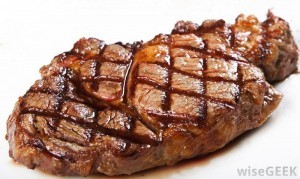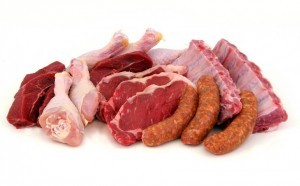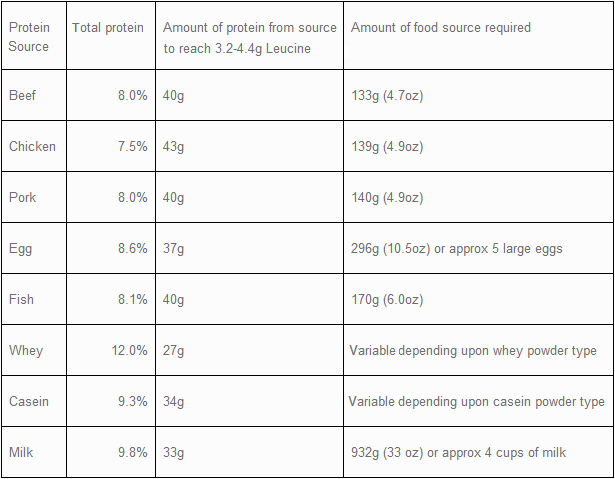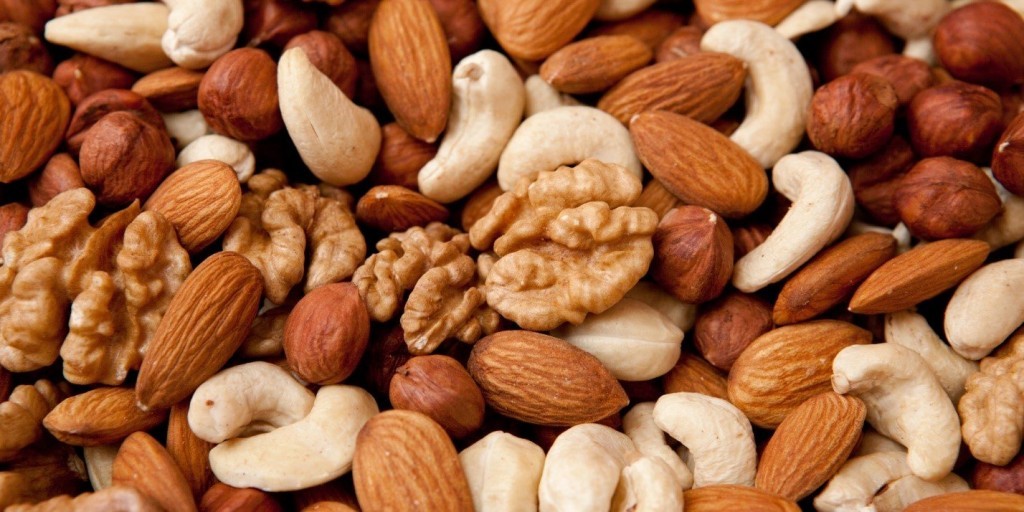While it has certainly been a while since the last installment of the Powerlifting Nutrition Series, the show must go on. Beginning with this article, we’re going to discuss the actual “how” of dieting for powerlifting. In order to do so, you must understand “macronutrients” and the role they play in setting up a powerlifting diet. Now, admittedly, much of this article is geared towards relative beginners to nutrition. If you don’t care to have the basics rehashed, if you don’t want to hear my rationale for my suggestions, and you just want to see my recommendations in a snap shot, simply skip the bottom of the article.
If you’d rather watch than read:
Macronutrition for Powerlifting
Right below calories in our umbrella of importance is macronutrition. You see, unfortunately, calories don’t tell the entire story. Intuitively, we all know that 3000 calories of bread do not have the same effect on the body as, say, 3000 calories of chicken breast.

There’s just something about steak. Amirite?
Photo: wisegeek.com
One of the reasons this is the case is that the food we eat are primarily composed of three macronutrients: proteins, fats, and carbohydrates. Fiber is another quasi-macronutrient of importance to us in powerlifting nutrition. Technically, it is a type of carbohydrate. We’ll address each of these macronutrients one by one, in order, to better understand their importance in powerlifting nutrition.
Before we get too far ahead of ourselves, it is important to note that entire books can, and have, been written on the subjects we are about to VERY briefly discuss. Nutrition is like a rabbit hole. In terms of complexity, it can go just about as far and as deep as you’re personally inclined to go. For our purposes, we’re going to try to focus on the information that is of practical importance to powerlifting nutrition specifically. The amazing and varied complexity of the entire topic of nutrition is going to be left to experts far more qualified than myself.
Protein for Powerlifting
What it is actually important to know is that your body is completely reliant on dietary protein. That is, even if you get enough calories, you will still die eventually if you don’t consume any protein. Proteins are the very building blocks of life. Dietary protein contributes to the maintenance, restoration, and function of virtually every important organ in your body.
Typical dietary protein sources include chicken breast, tuna, eggs/egg whites, turkey breast, protein powder, beef, fish, cottage cheese, and milk.
Please keep in mind that many foods have multiple macronutrients in them. 2% Milk, for example, has protein, carbs, and fats in it. When we get to talking about tracking macronutrients, remember that all of these should be accounted for and not just the protein. Do not only count the carbs in bread and do not only count the protein in meats. You need to count all the macronutrients in every food you eat in order to get an accurate picture of what you’re actually consuming.

Meat is my favorite source of protein.
Photo: rivesqualitymeat.com
As a member of the health and fitness community, or really anyone who has ever listened to anyone talk about “getting big”, you probably know that dietary protein is also necessary to help build new muscle tissue. Not only is dietary protein necessary to help build new muscle tissue, but it is also necessary to preserve what has already been built.
Again this primer on protein could easily consume another one-hundred pages. We’re not going to do that. If you want to learn everything there is to know about protein, I’d recommend Lyle McDonald’s protein book. For now, instead, let’s focus on the key take-away here: you HAVE to eat protein both to survive and to excel as a powerlifter.
How much Protein do you need for Powerlifting?
Ah, now this is really the million dollar question isn’t it? Really though, we shouldn’t be thinking in terms of how much protein we “need” as powerlifters; we should be thinking in terms of how much protein is optimal for building muscle and strength. Those are two separate questions.
Protein needs vary significantly between populations. In the United States, the FDA recommendations for daily protein intake are 60-80g depending on gender. Now, this may be appropriate for your average sedentary individual, but this number grossly underestimates the optimal protein intake of your average competitive powerlifter.
The traditional way to prescribe protein needs is based on body weight. A research review conducted in part by Dr. Eric Helms, who is both a PhD and an actively competing bodybuilder and powerlifter, would suggest that appropriate daily levels also depend on whether or not an individual is currently in a caloric surplus or a caloric deficit. In a surplus, slightly less protein is needed: ~0.8g-1.0g/lb or ~1.8-2.2g/kg. In a caloric deficit more protein is required to maintain muscle mass: ~1.1-1.4g/lbs or ~2.3g-3.1g/kg.
However, research done by Dr. Layne Norton, and several others, has recently suggested that muscle protein synthesis, specifically, is optimized on a per-feeding basis. That is, beyond a certain limit, dietary protein consumed in one sitting does not contribute to further muscle protein synthesis. This is not to say that the protein isn’t going to be used by the body at all, but it is to say that it isn’t used for further muscle building.
This research suggests that muscle protein synthesis may be optimized by consuming ~3-5g of Leucine every ~4-6 hours. Leucine is an amino acid which is a constituent of most proteins. The gist of the research is that the body does not become fully re-sensitized to amino acids in the blood stream for the aforementioned ~4-6 hour period because levels remain elevated until that time. If more protein is consumed before this sensitivity is regained, you receive a muted response in terms of maximally stimulating further muscle protein synthesis. In short, you don’t build as much muscle.

How much protein is required to reach the leucine threshold with various protein sources.
Photo: simplyshredded.com
While some in the fitness community debate the strength of the research supporting these findings, I’ve personally found adopting Dr. Norton’s suggested practices to be measurably effective both in terms of improving my strength and in terms of the overall amount of muscle I am able to carry at any given time. As such, I will echo his recommendations. If you personally disagree, protein needs can be determined using the traditional body weight metrics.
In simple terms, “getting enough protein” for powerlifting means eating ~4-6 meals per day that contain 30-50g of protein because this is approximately how much it takes to get 3-5g of Leucine per meal. If you’re towards the smaller side, you’ll need less leucine to elicit the optimal response. If you’re bigger, you’ll need more. Regardless, this all adds up to approximately 120g-300g of protein per day.
Personally, I’d recommend shooting for 5 meals per day of 30-50g of protein. Use your bodyweight as a rough guide to help you determine the total amount that you’ll split between the meals. For example, a 200lbs male might consume a total of 200g of protein consisting of five 40g meals. A 150lbs female might consume 150g of protein consisting of five 30g meals.
As you can see, when you get down to putting this into practice, it isn’t too terribly difficult.
Protein Needs Summary
Body Weight Method
- While in a Caloric Surplus: 1.8-2.2g per KG of bodyweight or ~0.8-1.0g per LB of bodyweight
- While in a Caloric Deficit: 2.3-3.1g per KG of bodyweight or ~1.1-1.4g per LB of bodyweight
Leucine Pulse Method
- 30-50g of protein per meal — higher end for heavier lifters and lower end for lighter lifters
- 4-6 meals per day
- Each meal is eaten 4-6 hours apart
- Recommendations do not change regardless of whether you’re in a surplus or deficit
Fat Intake for Powerlifting
Much like protein, dietary fat is essential for life. Dietary fat contains “essential fatty acids” (EFAs) that the body simply cannot synthesize on its own. A certain amount of dietary fat is also needed to optimize your hormonal milieu, joint health, brain function, and a whole host of other bodily functions. In short, you cannot go without fat. And, really, who would want to? Fat is one of the reasons most of our favorite foods taste so good.
Typical dietary fat sources include nuts, butter, cooking oil, avocado, and chocolate. Many cuts of meat also have generous portions of fat.

Nuts are a very common source of fats.
Photo: huffingtonpost.com
In short, we need fat to survive, keep our health in check, and to keep ourselves sane when dieting.
How much Fat do you need for Powerlifting?
Unlike protein, fat needs are a bit harder to pinpoint in terms of grams consumed. Your primary goals with fat intake are making sure you meet your needs for EFAs, keeping fat above reasonable minimums for health purposes, and ensuring you’re actually able to comply with your diet plan. An ultra-low fat diet tends to be a diet that we cannot adhere to in the long term.
In general, for most powerlifting populations, an appropriate level of fat is going to be anywhere from 15-30% of total caloric intake. The reason for the wide range in potential levels of fat intake has entirely to do with circumstances. However, as a reasonable minimum, ~0.3g/lbs or ~0.6g/kg is as low as you’re going to be able to push things without experiencing long term issues related to under-consumption of fat.
When a powerlifter is dieting, and trying to lose weight, it is important to keep carbohydrate levels high enough that hard training can be sustained. In order to keep carbohydrate levels up, even while calories levels are declining, it can be useful to use the lower end of the fat range when calculating how many grams of fat to eat. This is really a matter of asset allocation: you reallocate some calories to carbs and, in order to do so, you have to take away from fat. You can’t change protein because your protein needs are based on maintaining your hard earned muscle mass; protein needs don’t really vary.
For lifters who are not dieting, it makes sense to use a higher level of fat intake. It just simply isn’t necessary to use lower fat levels because you’ll have enough calories to work with that your carbohydrate levels will be high regardless. There is no need to punish yourself with a diet low in fat while in a surplus. You’ll enjoy your life far more if fat is kept higher than the minimum.
If you’re an older athlete, or someone who just doesn’t respond well to carbohydrates, consider the higher levels of fat in the above percentage range. As in everything, there is room for individuality. Remember, as I’ve repeatedly said, nutrition is a very deep and complex topic. These are general guidelines for large populations of powerlifters. You, however, are a specific individual. While the chances are that you are one of the many for whom these general guidelines work very well for, there is the off chance that you’d be better served with something very different. This is where powerlifting coaching can come into play to help you optimize your training and nutrition.
In general, for the vast majority of circumstances, you’re going to want about 20-25% of your total caloric intake to come from fat. And, again, as a reasonable minimum do not drop things below ~0.3g/lb or ~0.6g/kg for a lengthy period of time (or possibly at all).
Fat Needs Summary
Fat Intake for Powerlifting:
- While in a Caloric Surplus: 20-30% of Total Calories
- While in a Caloric Deficit: 15-25% of Total Calories
- Minimum Suggested Intake: 0.3g/lb or 0.15g/kg
Carbs for Powerlifting
I guess we finally get to talk about carbohydrates and glycogen, eh? Woohoo!
Typical sources of carbohydrates include: oatmeal, rice, potatoes, bread, vegetables, fruit, beans, fat free popcorn, fat free frozen yogurt, carbohydrate supplements (like dextrose, maltodextrin, waxy maize), and a variety of others.

Bread is one of the most common sources of carbohydrates.
picture: wisegeek.com
Of the macronutrients we’ve discussed thus far, carbohydrates are the only one that is technically “unnecessary” for survival. Even without dietary carbohydrates, you won’t die. While glucose is used to fuel brain function, and glucose requires glycogen which requires dietary carbohydrate intake, the body is capable of producing an alternative fuel called “ketone bodies” through the process of “ketosis”.
You see, when you don’t eat carbs, and you only consume fats and proteins, your body eventually enters the aforementioned state of ketosis. In an incredibly oversimplified generalization, ketosis is essentially a process by which your body begins to use fat as its main fuel source for everything (through ketone bodies). Many people have successfully used “keto diets” in order to accelerate their fat loss efforts. There is even some research to suggest that being in ketosis may have performance benefits for endurance athletes. However, as powerlifters, “keto diets” are not favorable, in my opinion, for a variety of reasons. Keep in mind that, again, we’re keeping this as simple as possible.
If you want the in-depth discussion on keto, the man to go to is Lyle McDonald who literally wrote the book on the subject (of ketosis).
Back to the point, high intensity, anaerobic exercise, such as lifting heavy ass weights, is primarily fueled by ATP (adrenosine triphosphate). ATP is created through a variety of cellular processes not all of which require the use of glycogen. With that said, as you begin to deplete your initial ATP stores, the body begins to preferentially break down glycogen in order to synthesize new ATP for further efforts. If you’re eating a low-carb diet, this just doesn’t happen because you have little or no glycogen stored in the muscles to fuel the process. While you may not notice a decrease in performance in your initial sets, your ability to sustain a high workload will generally suffer quite noticeably. If you cannot train as hard or as long, you cannot become as strong and you will not be able to maintain as much of your previously earned strength or muscle mass. As we’ve talked about elsewhere, steadily increasing volume is one of the most important factors when it comes to progress in the gym.
Additionally, there is some evidence to suggest, albeit statistically insignificant, that consuming carbohydrates with protein slightly enhances the total muscle protein synthesis stimulated by that particular feeding.
As such, carbohydrates, in my eyes, are both critical to performance enhancement in terms of sustaining and increasing your workload and weight management in terms of maximizing the amount of muscle you gain or keep while dieting.
How many Carbs do you need for Powerlifting?
It is important to remember the primary purpose that carbohydrates serve in powerlifting nutrition: fuel hard training. Now, if you were so inclined, you could probably determine, with semi-reasonable accuracy, approximately how much glycogen your training was consuming. From there, you could plot out exactly how many carbs you needed, how much protein you needed, and then you could allocate the rest of your calories towards fat. You’ve probably already noticed that isn’t the approach I’ve advocated in this article and there are several reasons why.
First of all, if you’ve read ProgrammingToWin, you know that I STRONGLY endorse an autoregulated training style. With an autoregulated training style, I never know exactly how much work I’m going to do in a given session. Additionally, I’m constantly striving to push myself to do more work and harder work than I’ve ever done before. In other words, there is variance in how much glycogen I go through in any given training session. Further, I typically train six days per week.
Rather than trying to approximate exactly how many carbohydrates I need to properly fuel my training, I prefer to set my protein intake, then set my fat intake as a percentage of my total caloric intake (assuring I’m above the reasonable minimum), and I allocate literally everything else to carbohydrate intake. Using this method, my carbohydrate intake is as high as it can possibly get. Whether I am dieting or gaining weight, because my carbs are kept “high”, I’m likely to have enough glycogen in the tank to perform long, hard training sessions. Because of this type of allocation of macronutrients, many of my athletes, including myself, have actually experienced strength gains while dieting. Because we have a plethora of carbohydrates in our diet, we have enough energy to occasionally set volume and workload personal records even while in a caloric deficit. If you set volume personal records, rep and max records aren’t too far around the corner.
Again, let’s remember all the benefits of eating a diet higher in carbohydrates:
- Water is required to store glycogen in the muscles. Added size at the joints from the stored water improves your leverages under the bar.
- When your glycogen tank is full, you have the high amount of energy substrates you need to produce ATP and survive long, hard, grueling workouts without hitting a wall.
- Dietary carbohydrates may increase muscle protein synthesis when consumed at the same time as dietary protein.
For all these reasons, in terms of carbohydrate needs, I recommend using all of the calories you have left after accounting for protein and fat needs.
Carbohydrate Needs Summary
Allocate all remaining calories to carbohydrates after accounting for protein and fat needs.
Fiber for Powerlifting
Technically speaking, fiber is a type of carbohydrate. Essentially though, fiber is the indigestible material that is found in plants, fruits, whole grains, and a variety of other foods. The “substance” of fiber is such that it resists our natural digestive enzymes. While we can glean some energy from the processing of dietary fiber, for the most part, fiber’s real job is to act as “nature’s broom”. This undigested material pushing through our digestive system helps us “clean out”. Hey man, in the end, fiber makes it easier to poop.
In all seriousness, a certain level of fiber is necessary for gut health. With that said, you can definitely take it too far. Consuming TOO much fiber can potentially blunt nutrient absorption and actually impede proper bowel movements.
Typically, for a powerlifter’s diet, I actually use fiber as a proxy for diet quality. If someone is eating nothing but fatty foods and sugar, they won’t be getting a reasonable amount of fiber. Those types of foods typically do not have any fiber whatsoever. Fiber content per gram is highest in your typical “healthy” foods like fruits and vegetables. As such, as I’ve mentioned, fiber intake itself is a good indicator of the overall quality of your diet.
To keep food quality high in your diet, and to keep your gut in check, I’d recommend keeping your fiber intake between 10-20% of your total carbohydrate intake. That is, for every ~100g of carbs you consume, try not to eat less than 10g of fiber and try not to eat more than 20g. This general rule of thumb will serve you well in 99% of situations. Keep in mind that this recommendation is not additional fiber on top of your carbohydrate intake but rather this fiber recommendation is made as a percentage of whatever your total carbohydrate intake already is. Additionally, as a reasonable minimum for most people, I’d recommend 20g of fiber per day for gut health, staying regular, and general well-being.
Fiber Needs Summary
Fiber Percentage of Total Carbohydrate Intake: 10-20%
Minimum Suggested Fiber Intake: 20g per day
Recommended Macros for Powerlifting
- While in a Caloric Surplus: 1.8-2.2g per KG of bodyweight or ~0.8-1.0g per LB of bodyweight
- While in a Caloric Deficit: 2.3-3.1g per KG of bodyweight or ~1.1-1.4g per LB of bodyweight
Leucine Pulse Method
- 30-50g of protein per meal — higher end for heavier lifters and lower end for lighter lifters
- 4-6 meals per day
- Each meal is eaten 4-6 hours apart
- Recommendations do not change regardless of whether you’re in a surplus or deficit
- While in a Caloric Surplus: 20-30% of Total Calories
- While in a Caloric Deficit: 15-25% of Total Calories
- Minimum Suggested Intake: 0.3g/lb or 0.15g/kg
- Allocate all remaining calories to carbohydrates after accounting for protein and fat needs.
- Fiber Percentage of Total Carbohydrate Intake: 10-20%
- Minimum Suggested Fiber Intake: 20g per day
The Importance of Energy Balance and Macronutrition
Before we move on in the Powerlifting Nutrition Series, I want to expound upon the relative importance of what we’ve covered thus far. Perhaps the single most important objective I had when I decided to offer a basic primer on nutrition in these last few articles was to help you clarify what matters most when designing a nutritional protocol for powerlifting.
With that in mind, please pay attention to what I’m about to say next: getting your caloric intake and macronutrition handled correctly is responsible for at least 80% of your progress nutritionally speaking. To reiterate and state it differently, once you’ve got the correct caloric intake and macronutrient breakdown in your diet, you can only make marginal improvements to your nutrition protocol through virtually any other means. In all honesty, 80% is probably low balling the true contribution of just those two factors.
I don’t know how else I can put this other than to say that, relative to macronutrition and energy balance, supplements, meal frequency, nutrient timing, and food quality just aren’t that important. They just aren’t. While 99% of “diets” differentiate themselves using the four aforementioned properties and qualities, realistically, they are the factors least responsible for your nutritional success or failure.
Don’t forget your calories. Don’t forget your macros. Everything else matters a lot less.
Did you enjoy the Powerlifting Nutrition Series?
If so, I highly recommend you check out our eBook: EatingToWin. The book contains absolutely everything you need to know about how to set up the optimal diet for YOU personally as a powerlifter, how to identify the right weight class to maximize your competitiveness, how to cut weight like a PRO so that you can drop a weight class without performance loss, and, of course, an entire section on recommended supplements with the supporting evidence behind each recommend. Grab your copy now!
Like this Article? Subscribe to our Newsletter!
If you liked this articled, and you want instant updates whenever we put out new content, including exclusive subscriber articles and videos, sign up to our Newsletter!
Questions? Comments?
For all business and personal coaching services related inqueries, please contact me:
Table of Contents
Powerlifting Nutrition: How To Pick Your Weight Class
Powerlifting Diet: Cutting and Bulking
The Best Way To Measure Body Fat For Powerlifting
When To Move Up A Weight Class
How To Cut Weight For Powerlifting: 24 Hour and 2 Hour Weigh Ins
How To Diet For Powerlifting: Calories, Reverse Dieting, and More
Setting Up Your Powerlifting Macros
Meal Frequency and Nutrient Timing in Powerlifting
Eating Healthy for Powerlifting
Best Powerlifting Supplements